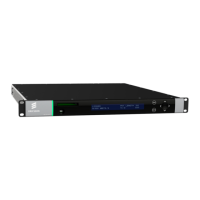Using the Equipment
• Lock Status – This field indicates if the satellite input option is locked to the
incoming carrier or not.
• Signal Level – This field displays the estimated input power of the wanted
carrier.
• Error Ratio – This field displays the Error Ratio for the demodulated data. In
DVB-S mode the field displays the post Viterbi error ratio. A level of 2E-4
indicates that the Quasi Error Free point where the signal is deemed to be failing
has been reached. In DVB-S2 mode the field returns the Packet Error ratio. A
level of 1E-7 indicates that the Quasi Error Free point where the signal is
deemed to be failing has been reached.
• C/N – This field displays an estimate for the system carrier to noise ratio
(absolute) on the received signal in units of dB.
Note: System C/N may not be equivalent to down-link C/N. It is not possible for
the IRD to differentiate between the system noise floor and the down-link
noise floor. Most satellite links are designed so that they are down-link
thermal noise (rain fade) dominated. However, some satellite links can also
be affected by system issues such as cross-polar interference, adjacent
channel interference, adjacent satellite interference, cable tilt, etc.
• C/N Margin – This field displays an estimate for the system carrier-to-noise
margin to failure for the received signal in units of dB. When the C/N Margin
reads 0 dB the demodulator is likely to be at the Quasi Error Free point and on
the verge of failing.
Note: System C/N Margin may not be equivalent to down-link C/N Margin. It is not
possible for the IRD to differentiate between the system noise floor and the
down-link noise floor. Most satellite links are designed so that they are
down-link thermal noise (rain fade) dominated. However, some satellite links
can also be affected by system issues such as cross-polar interference,
adjacent channel interference, adjacent satellite interference, cable tilt, etc.
• Standard – This field displays the modulation standard for the incoming, locked
signal: DVB-S or DVB-S2.
• Modulation – This field displays the modulation type for the incoming, locked
signal: QPSK, 8PSK etc.
• FEC – This field displays the FEC for the received signal.
• Spectral Sense – This field displays the whether the incoming frequency
spectrum has become inverted due to frequency up or down-conversion
processes in either the up-link or down-link location.
• Pilot Symbols – This field indicates if DVB-S2 pilot tones are in use on the
transmitted signal.
Ericsson recommends the use of DVB-S2 pilots for the following modulations:

